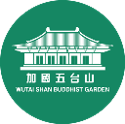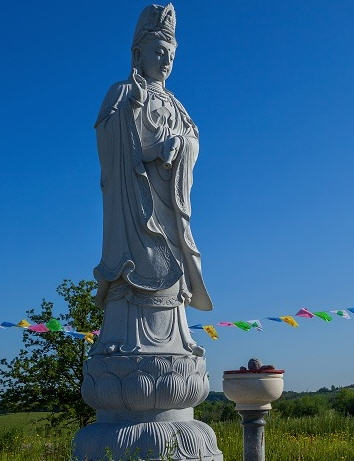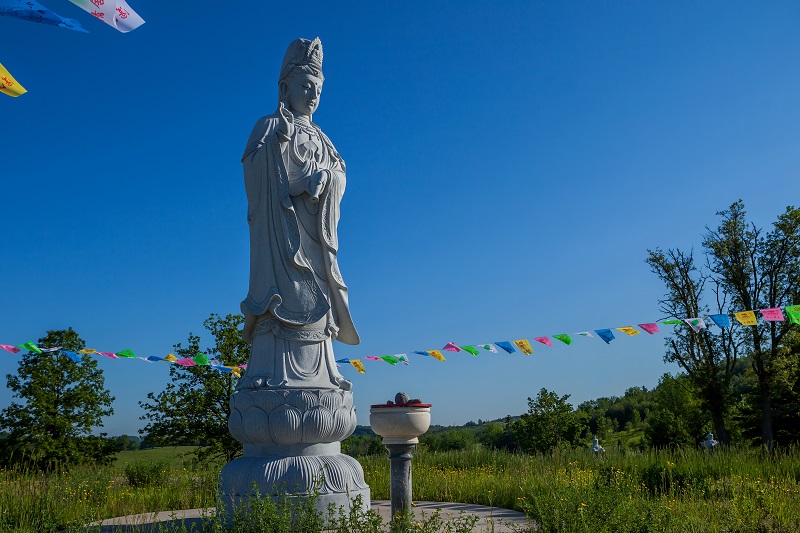Avalokitesvara Bodhisattva with Willow Twig
楊柳觀音
Hello everyone. Welcome to Wutai Shan Buddhist Garden in Canada. On the left side of Bodhi 2nd Rd., there is a house that was constructed a hundred years ago. Facing this house is a statue of Avalokitesvara Bodhisattva with Willow Twig.
This Avalokitesvara Bodhisattva with Willow Twig statue has a head covering and wears an elegant, jewelled crown. The crown is adorned with an image recognized by people everywhere: Amitabha Buddha. The facial features of Avalokitesvara Bodhisattva with Willow Twig imply that she is looking downwards, with her earlobes drooping over her shoulders, like she is compassionately watching over all sentient beings.
Her hands are forming the Teaching Mudra, with her left hand holding a bottle made out of pure jade. Sprinkling the sweet rain of Dharma, she rescues all living beings. She is seated barefoot atop a lotus flower, dignified and tranquil, evoking a sense of awe.
It is no secret that Avalokitesvara Bodhisattva with Willow Twig liberates all sentient beings from their suffering, and guides them to the shore of enlightenment. She is the transformation body of one of the most widely known and influential Bodhisattvas. Visual depictions usually show her standing or sitting on a rock, with her right hand holding a willow branch, signifying the Willow Hand Samadhi of the Thousand-Armed Avalokitesvara Bodhisattva. She is typically presented as a female, wearing a woman’s shawl. The willow branch symbolizes the blessing of the Bodhisattva in our lives, which just like the rain, can be seen everywhere.
Believing in the spiritual power of willow trees, the people of Ancient China listed Avalokitesvara Bodhisattva with Willow Twig as the first of Avalokitesvara Bodhisattva’s thirty-three transformations. She shakes the willow branch, the way that insight shakes the mind. Yet, the water remains clear and motionless, like the cessation of mental activity. Since she is often called upon to avoid calamities, heal sicknesses, and prevent natural disasters, she is also known as Avalokitesvara Bodhisattva The Medicine Queen.
What makes this statue of Avalokitesvara Bodhisattva with Willow Twig special and unique?
Wutai Shan’s Avalokitesvara Bodhisattva with Willow Twig has been spiritually purified by the Monks and Nuns of Cham Shan Temple, and infused with the compassion of the Avalokitesvara Bodhisattva. If she is sincerely prayed to, the Bodhisattva can heal all sentient beings and relieve their suffering. Furthermore, willow trees can effectively ward off evil spirits. In the past, when modern medicine was not yet developed, some babies were weak and physically unwell. On these occasions, a peach or willow branch would be tied to the side of their body to repel evil spirits, avoid accidents, and fend off serious illnesses. Likewise, Avalokitesvara Bodhisattva with Willow Twig protects the health and wellness of children, promoting optimal childhood development.
阿彌陀佛,大家好,歡迎來到加國五台山。在五台山菩提二路的左側,有一個百年歷史的古屋,而在古屋的對面就是楊柳觀音聖像了!
這尊楊柳觀音聖像頭披著道巾,戴著莊嚴的寶冠,在寶冠上佩戴著一尊化佛,這尊佛就是大家熟知的阿彌陀佛了。楊柳觀音眉目低垂,圓潤的雙耳垂在肩上,好像是在俯瞰眾生一樣,慈悲流露!
楊柳觀音聖像右手結說法印,左手持玉淨瓶,遍撒甘霖、救度眾生。赤腳踏在蓮座上,聖像非常端莊淑艷,令人肅然起敬!
大家都知道,楊柳觀音是救苦救難、普渡眾生、廣為民間傳誦的影響深遠的菩薩化身之一。造型一般為立像,踞坐岩上,右手執楊柳,表千手觀音之楊柳手三昧。常戴女式風貌和披肩長巾。楊柳比喻菩薩利生的恩澤,恰似楊柳隨風蕩漾,無處不現身。
自古以來中國人相信柳枝具有靈力,因而將楊柳觀音命名為觀世音菩薩三十三種應化身的第一尊。楊柳觀音的楊柳為拂動之物,象徵〝慧〞;淨水為清澈之物,象徵〝定〞,用以消災解除疾病、災厄,因此,楊柳觀音又被稱為“藥王觀音” 。
五台山的楊柳觀音聖像有什麼特別和殊勝之處呢?
五台山的楊柳觀音聖像是經過湛山諸位長老法師的灑淨開光,經由觀音菩薩的慈悲加持,如果虔誠禮拜稱名,菩薩可以為眾生治病,消除眾生身體疾病苦痛。楊柳有避邪的功效,以前醫學不發達,嬰兒有的體弱多病,在身邊繫綁桃枝、柳枝,用以避邪消災除病難,所以五台山楊柳觀音聖像也可以保佑小孩子健康順利成長!


